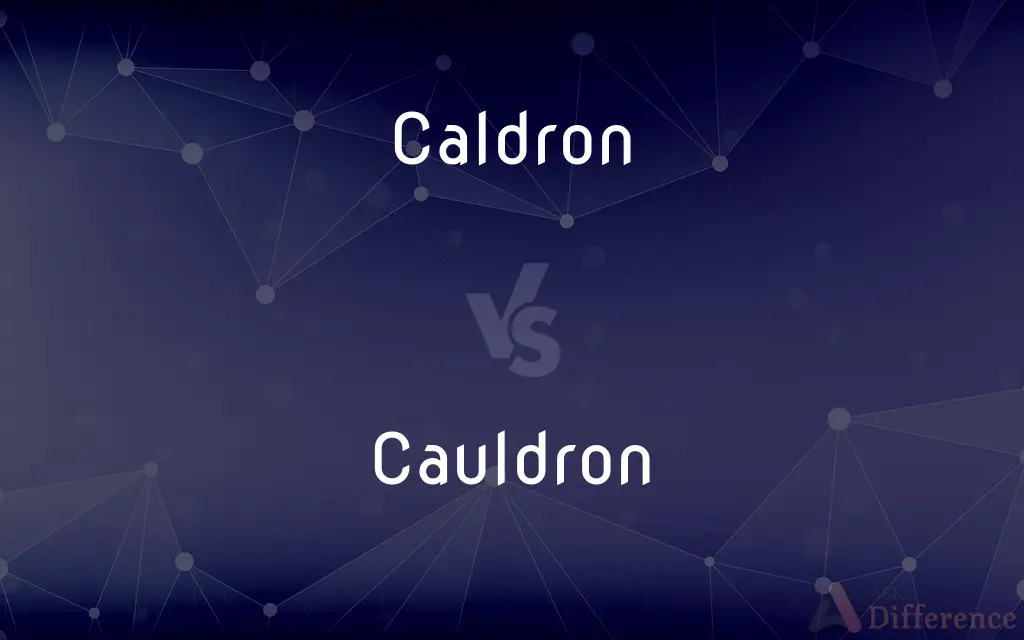Caldron vs. Cauldron — What's the Difference?
By Urooj Arif & Maham Liaqat — Updated on February 23, 2024
Caldron is an alternate, less common spelling of cauldron, a large metal pot used for cooking or boiling over an open fire.

Difference Between Caldron and Cauldron
Table of Contents
ADVERTISEMENT
Key Differences
Cauldron, the more commonly used term, refers to a large metal pot with a lid and handle, often depicted in tales of witchcraft and historically used for cooking over an open fire. Caldron, while technically an acceptable variant, is less frequently encountered in modern English. Both terms evoke images of bubbling potions and communal meals in large gatherings, but cauldron's prevalence in literature and popular culture has solidified its position as the preferred spelling.
The use of a cauldron is often associated with traditional cooking methods, communal meals, and in folklore, magical potions and witchcraft. Caldron, sharing the same meanings and uses, is simply an orthographic variant that one might come across in older texts or in diverse linguistic contexts. Despite their interchangeable meanings, the spelling "cauldron" is more likely to be recognized and understood, reflecting its dominance in English usage.
In literature and mythology, the cauldron is imbued with symbolic meanings, from the cauldron of the Welsh legend Cerridwen to Shakespeare's "Macbeth," where it is a vessel of transformation and magic. Caldron, when used, carries the same connotations but might be perceived as an archaic or stylistic choice, emphasizing a historical or mystical ambiance.
The choice between caldron and cauldron often comes down to personal or editorial preference, with cauldron being favored for its familiarity and standardization in modern English. Both terms, however, serve to conjure images of warmth, community, and in certain contexts, the mystical and the arcane.
Comparison Chart
Spelling
Alternate, less common
Standard, widely accepted
ADVERTISEMENT
Usage
Found in older texts, less prevalent
Common in modern English, literature
Connotations
Same as cauldron, can feel archaic
Associated with witchcraft, cooking
Recognition
Might be less recognized
Universally recognized
Cultural References
Same as cauldron, but less used in popular culture
Frequent in folklore, mythology, and popular culture
Compare with Definitions
Caldron
Can signify a large quantity.
A caldron of troubles seemed to follow him.
Cauldron
A large metal pot with a handle and lid.
The witch brewed her potions in a large cauldron.
Caldron
An alternate spelling for a large metal pot.
The stew was simmering in the caldron over the open fire.
Cauldron
Used for boiling or cooking over fire.
They cooked the communal soup in a hefty cauldron.
Caldron
Used historically for cooking.
The ancient caldron was found at the archaeological site.
Cauldron
Represents abundance or magical transformation.
The cauldron was filled to the brim with gold.
Caldron
Sometimes used in poetic or archaic contexts.
The witches gathered around the bubbling caldron.
Cauldron
Commonly recognized term.
The Halloween decoration included a plastic cauldron filled with candy.
Caldron
Less common in contemporary usage.
He stumbled upon the word caldron in an old cookbook.
Cauldron
Symbolic in folklore and fantasy.
The cauldron of Cerridwen is said to grant wisdom and inspiration.
Caldron
Variant of cauldron.
Cauldron
A cauldron (or caldron) is a large pot (kettle) for cooking or boiling over an open fire, with a lid and frequently with an arc-shaped hanger. In other words, a large kettle.
Caldron
A large kettle or boiler of copper, brass, or iron. [Written also cauldron.]
Cauldron
A large vessel, such as a kettle or vat, used for boiling.
Caldron
A very large pot that is used for boiling
Cauldron
A large bowl-shaped pot used for boiling over an open flame.
Cauldron
A very large pot.
Common Curiosities
Are caldrons still used today?
While less common in everyday cooking, large pots akin to cauldrons are used for communal meals and in certain traditional cooking methods.
Can "caldron" and "cauldron" be used interchangeably?
Yes, they can be used interchangeably, as they refer to the same object.
Why is "cauldron" more popular than "caldron"?
"Cauldron" is more popular due to its widespread use in literature, popular culture, and its standardization in modern English.
How are cauldrons associated with witchcraft?
Cauldrons are iconic in witchcraft and folklore as vessels for brewing potions and performing magical rituals.
What is typically cooked in a cauldron?
Historically, cauldrons were used for boiling large quantities of food, such as stews and soups, especially over open fires.
Is "caldron" a correct spelling?
Yes, "caldron" is an alternate but less common spelling of "cauldron."
What materials are cauldrons traditionally made from?
Traditionally, cauldrons were made from metals like iron or copper, chosen for their durability and heat conductivity.
Do "caldron" and "cauldron" have the same origins?
Yes, they share the same etymological origins, with "cauldron" being derived from the Latin "caldarium," meaning "hot bath."
Was "caldron" ever the preferred spelling?
"Caldron" may have been more commonly used in the past, but "cauldron" has become the preferred spelling over time.
Can "caldron" refer to something metaphorical?
Yes, both "caldron" and "cauldron" can be used metaphorically to denote a situation or place filled with turmoil or activity.
How do I choose between "caldron" and "cauldron" in my writing?
"Cauldron" is recommended for clarity and recognition, but "caldron" can be used for stylistic or historical effect.
Is "caldron" considered outdated?
"Caldron" may be considered archaic or less standard in contemporary English, but it is not incorrect.
Do cauldrons have a specific shape?
Cauldrons are typically depicted as round pots with a wide opening and a curved handle, designed for hanging over a fire.
Can "caldron" be used in formal writing?
While technically correct, "cauldron" is preferred in formal writing due to its standardization and recognition.
Are there modern equivalents to cauldrons?
Large pots and industrial kettles used in commercial kitchens can be considered modern equivalents of cauldrons.
Share Your Discovery

Previous Comparison
Mammaw vs. Mamaw
Next Comparison
Automatize vs. AutomateAuthor Spotlight
Written by
Urooj ArifUrooj is a skilled content writer at Ask Difference, known for her exceptional ability to simplify complex topics into engaging and informative content. With a passion for research and a flair for clear, concise writing, she consistently delivers articles that resonate with our diverse audience.
Co-written by
Maham Liaqat















































